Recent Articles
Popular Makes
Body Types
2017 Chevrolet Corvette vs 2017 Porsche 911: Which is Best?
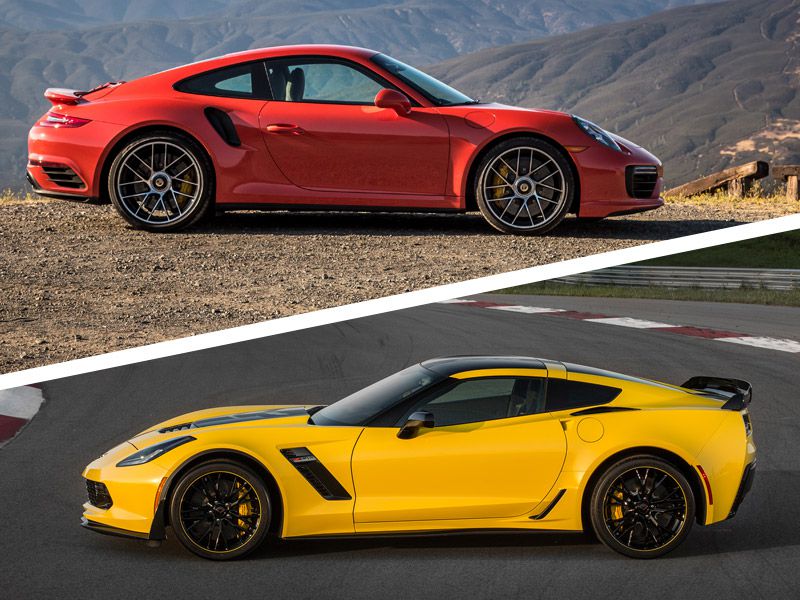
2017 Porsche 911 vs 2017 Chevrolet Corvette profiles ・ Photo by General Motors and Porsche
We imagine a lot of you might be saying “Wait, what? Corvette vs. 911? Could those cars be any different? Who would even consider such a comparison?” Our answer: A lot of people. The Corvette and the 911 might have opposite approaches and very different fan bases, but both accomplish the same thing: They are epic, world-class performance cars. In fact, we’ve heard stories of Porsche 911 fans who buy Corvettes as track cars, because they’re great performers and much cheaper to buy (and fix). Let’s delve in further and see if we can determine which is best, the Chevrolet Corvette or the Porsche 911.
Pricing and Trim Levels
No question, the Corvette is the price leader, with the Stingray model starting at $56,445. At the top end of the lineup is the Z06, which has a lightweight structure, advanced suspension, and a supercharged V8. By supercar standards, the Z06 is a bargain at $81,440. In the middle is the Grand Sport, which combines the Z06’s structure with the Stingray engine, all for a $66,445 base price. All are offered in three trim levels (1LZ, 2LZ and 3LZT for the Z06 and 1LT, 2LT and 3LT for the others) as well as coupe and convertible body styles. The 911 lineup is much more comprehensive. At the bottom end is the 911 Carrera, which lists for $90,050, and at the top end is the 911R, priced at $185,985 (and already sold out). In between are a staggering eleven more models: Carrera S, Carrera 4, Carrera 4S, Targa 4, Targa 4S, Turbo, Turbo S, Carrera GTS, Carrera 4 GTS, Targa 4 GTS, and GT3 RS, with all but the top two offered as coupes or convertibles. Confused yet? Imagine the poor Porsche sales reps who have to have all this memorized!
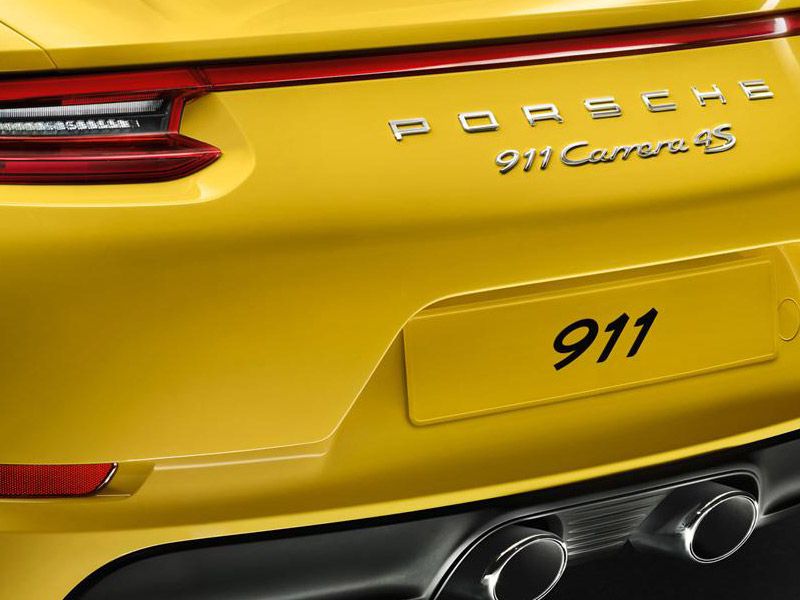
Photo by Porsche
Options
The Corvette is available with a large array of options. Most of the comfort and convenience features are bundled by trim level; there are a couple of option packs and a lot of standalone features, some of which improve performance and many of which are appearance-related, such as wheels, painted calipers, and a transparent roof. But when it comes to options, the Corvette (or any other car that we can think of) can’t hold a candle to the 911. One can only stand in awe of the 911’s option list; write them all out in a single line, and you’d probably need a strip of paper the length of the Equator. Performance options, interior options, wheel options, trim options, paint options—the number of permeations boggle the mind. Porsche will literally paint and upholster your 911 any shade of any color you desire if you have the money (seven grand for custom paint and $5,600 for custom leather). Keep in mind, however, that you can add enough options to your 911 to literally double the price.
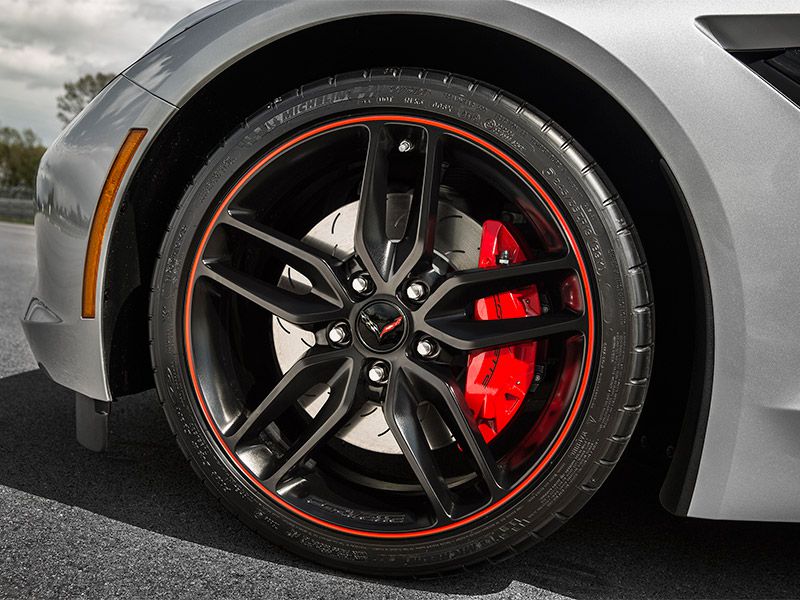
Photo by General Motors
Powertrains
The Corvette offers two engine options: Stingray and Grand Sport models get a 6.2-liter V8 that puts out 460 horsepower, while the ZL1 gets a supercharged version good for 650 horsepower. Chevy claims a 0-60 time of 3.7 seconds for the Stingray and 2.95 seconds for the Z06. The 911 is best known for its flat-6 engine; this year, all feature twin turbochargers to boost power. Horsepower depends on model: The Carrera, Carrera S and GTS get a 3.0-liter engine tuned for 370 hp, 420 hp, and 450 hp, respectively, while the Turbo and Turbo S models get a bigger 3.8-liter unit that produces 540 hp and 580 hp, respectively. GT3 RS and R models get 500 horsepower. The slowest of the group is the Carrera, which Porsche says will get to 60 mph in 4.4 seconds; the quickest is the Turbo S, which does it in 2.9 seconds—just 5/100 of a second ahead of the Corvette Z06.
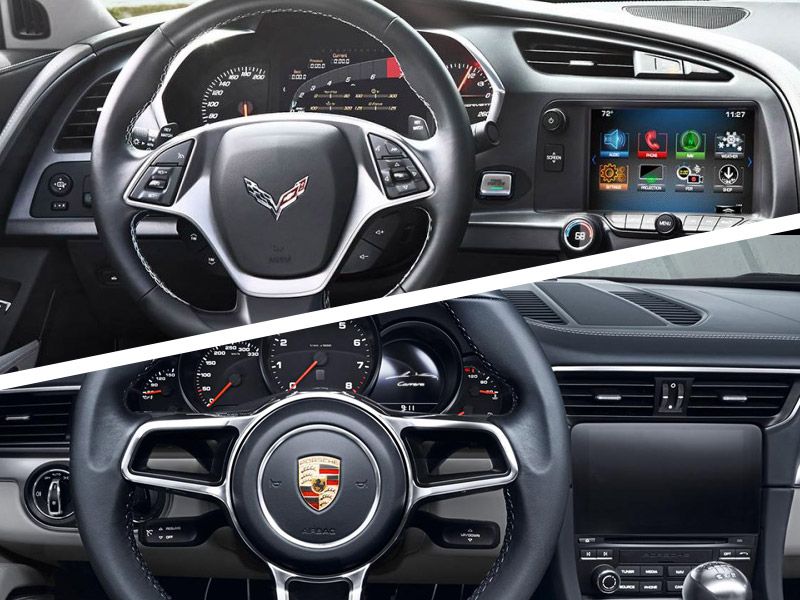
Photo by General Motors and Porsche
Standout Features
Picking a standout feature is like choosing which of your children is your favorite—they all have such different talents. We’re partial to the V8 engine in the Corvette; it produces gobs of power and screams a rebel yell which is uniquely American. That said, we also like the Corvette coupe’s removable roof panel—it provides almost the same open-top experience as the convertible, with less complexity and cost. From a technological standpoint, there’s a lot to like about the 911, but we are fascinated by the fact that you can get the 911 in any color you like, inside or out. Supply a color sample and they’ll paint your car to match. Cars like this are designed to stand out from the crowd, and what better way is there, other than a unique color, to make your 911 truly your own?
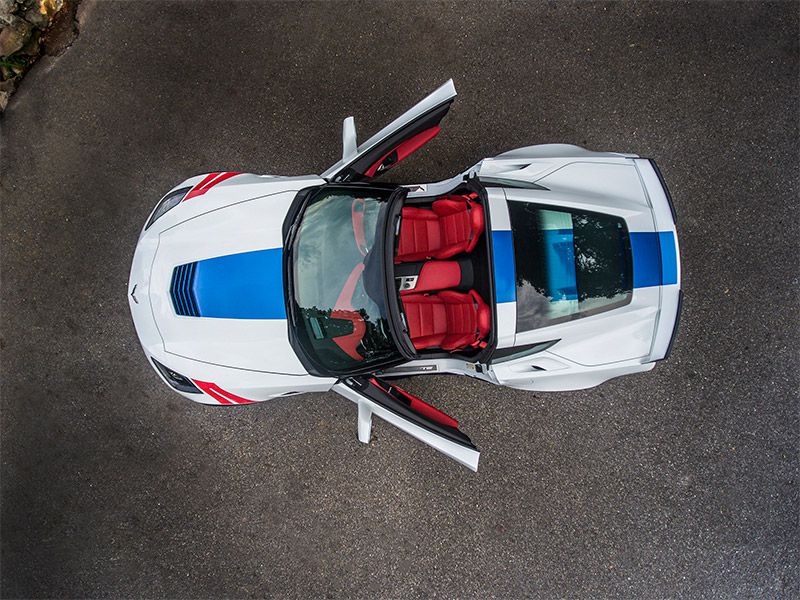
Photo by General Motors
Exterior Design
Here, the two cars are as different as can be. The Corvette’s shape is a classic, though we must admit that we’re partial to the simplicity of the base-model Stingray. The Grand Sport and Z06 have extra aerodynamic add-ons that border on cartoonish. Contrast that with the 911’s classic lines, which haven’t changed much since the first 911 was introduced in the 1960s. The aerodynamic equipment on high-end models makes them look more like serious race cars.
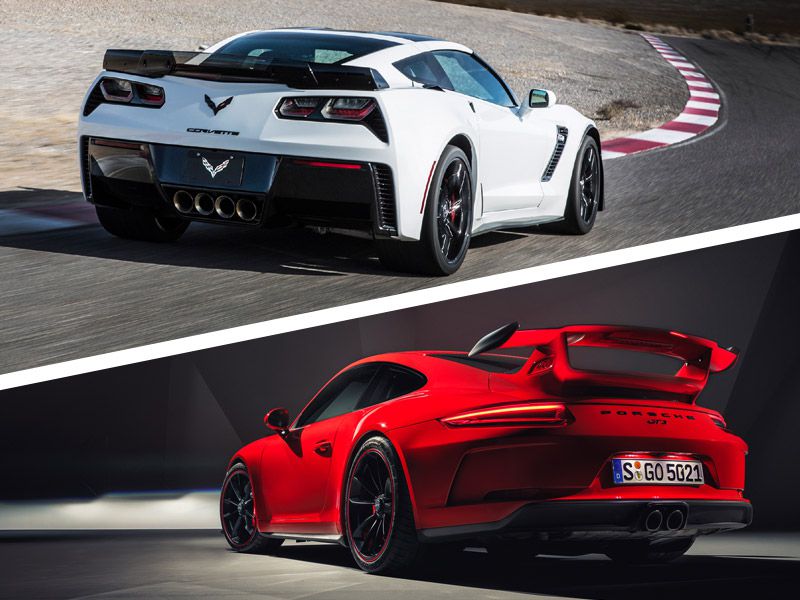
Photo by General Motors and Porsche
Interior Design
The interior has long been a Corvette weak point, something Chevrolet has addressed in this latest version. They’ve gone out of their way to make the cabin both functional and pleasing to the eye. We love the style and control placement, and if the quality of a few trim pieces is disappointing, we can easily forgive given the Corvette’s bargain price. Still, the 911’s interior is a true work of art. Covered in rich leather and with the tachometer pitted front-and-center in the instrument cluster, the 911’s cabin is both a timeless classic and a modern masterpiece. As we’ve mentioned, Porsche offers what seems like a billion different interior trim and color combinations, so you can literally customize the interior to your liking—although there’s nothing in the order guide that prevents an individual with bad taste from creating a truly hideous 911 cabin.
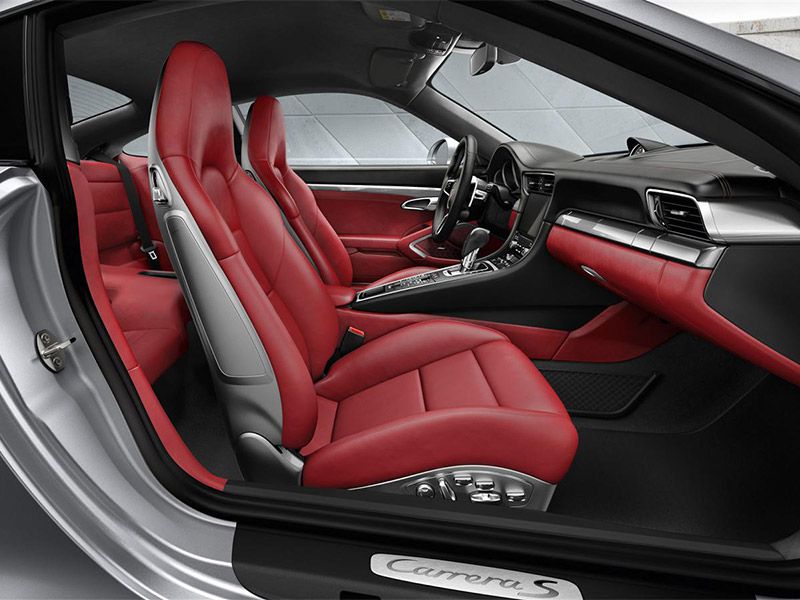
Photo by Porsche
Cargo Capacity
Clearly, one doesn’t make a decision about a car like this based on cargo space, but if you’re really worried about the trunk, buy the Corvette coupe—it offers 15 cubic feet of space with a large opening. The 911, by comparison, has only 5.1 cubic feet of luggage space, and since the engine is in the rear, the trunk is up front—right behind the radiators, which means the trunk gets hot, which means your frozen groceries may thaw before you get home. That said, the Porsche 911 does have a back seat, which is a great place to store cargo. The Corvette is a 2-seater.
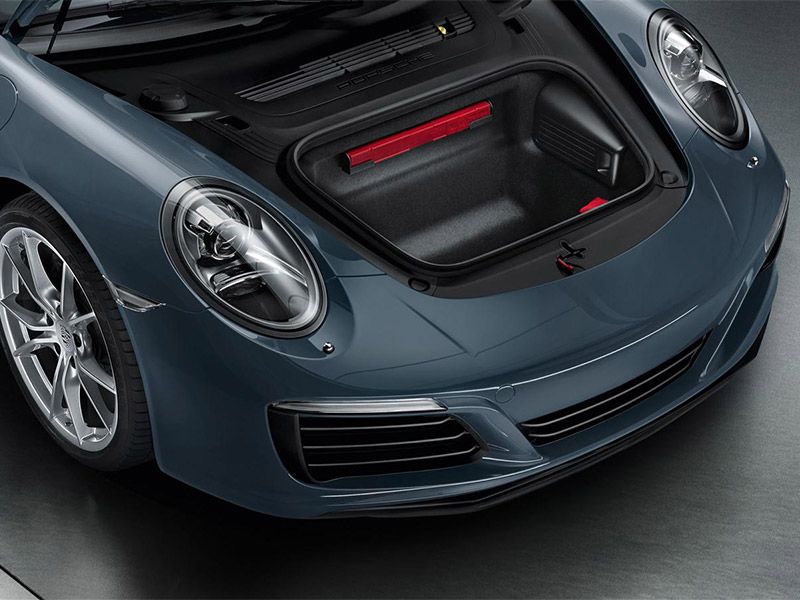
Photo by Porsche
Performance
Picking between these two is harder than you might think. Many who have never driven a Corvette would never imagine it could be the equal of the 911, but a turn behind the wheel on a good curvy road will teach them otherwise. Though not quite as refined as the 911 (and isn’t that part of its appeal?) the Corvette is an exceptionally competent road car. We love its multi-mode stability control system, which allows drivers with average skills to drive like a superhero (though if you turn it off completely, don’t be surprised if the Corvette swaps ends on you). The Z51 package sharpens the Corvette Stingray’s reflexes significantly, losing a bit of ride quality as a trade-off. The Grand Sport sets the bar even higher, and the Z06 is a true supercar, one that, given a long enough road and a skilled driver, can go toe-to-toe with Ferraris and Lamborghinis, albeit in a slightly-uncouth way. The 911 is another kettle of fish. Its rear-mounted engine is, basically, a bad idea, and Porsche has spent years taming its tail-happy tendencies; modern electronics have solved the problem nicely. A good driver can make serious time in a 911, but this car isn’t so much about top-end abilities (which, don’t misunderstand us, are prodigious) as it is about the experience. Everything about this car, from steering response to the sound of the exhaust, is designed to remind the driver that you are in a 911. The car delivers the experience so well that it could practically be bottled. A trip down the street to the store in a Corvette feels like a wasted opportunity, but the same trip in a 911 is a drive.

Photo by General Motors and Porsche
Which Is Best?
Which is best? That depends on your perspective. If you’re looking for maximum bang-for-the-buck, it’s impossible—and we mean that; completely and utterly impossible—to beat the Corvette. You could spend twice as much on a bare-bones 911 GTS (if you can even find a bare-bones GTS) as you would on a bare-bones Corvette, and the ‘Vette would still beat the 911 to 60 mph by a significant margin. The Corvette may seem loud and crude by comparison; some of its engine technology is downright rudimentary compared to the 911. But it works: In terms of getting from Point A to Point B as rapidly as possible (even assuming the road is not straight), the Corvette does the job just as well, if not better, and it’ll paste a Texas-sized grin on your face. That said, we can’t dismiss the 911. Like the Corvette, it’s an institution, and Porsche have elevated what was once a simple German sports car into an icon of prestige and panache. The 911 certainly delivers a thrilling driving experience, but it does so with a grace and elegance to which the Corvette simply cannot even aspire. It’s a Saville Row suit, whereas the Corvette is an old plaid shirt and well-worn pair of blue jeans. Both achieve the same ends, but one has significantly more style.
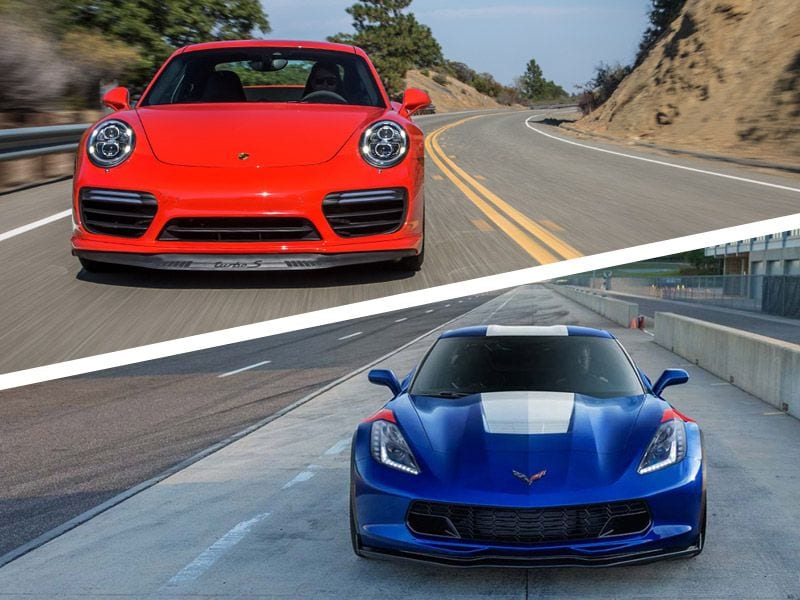
Photo by General Motors and Porsche